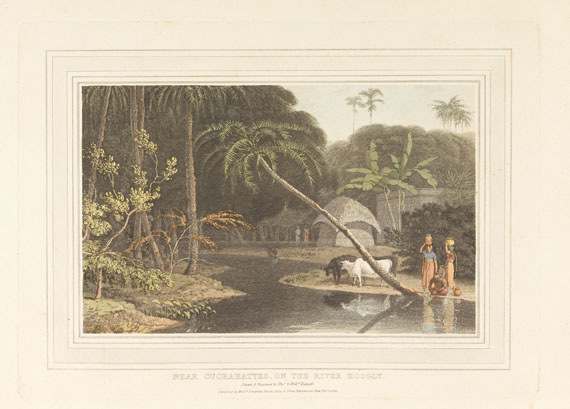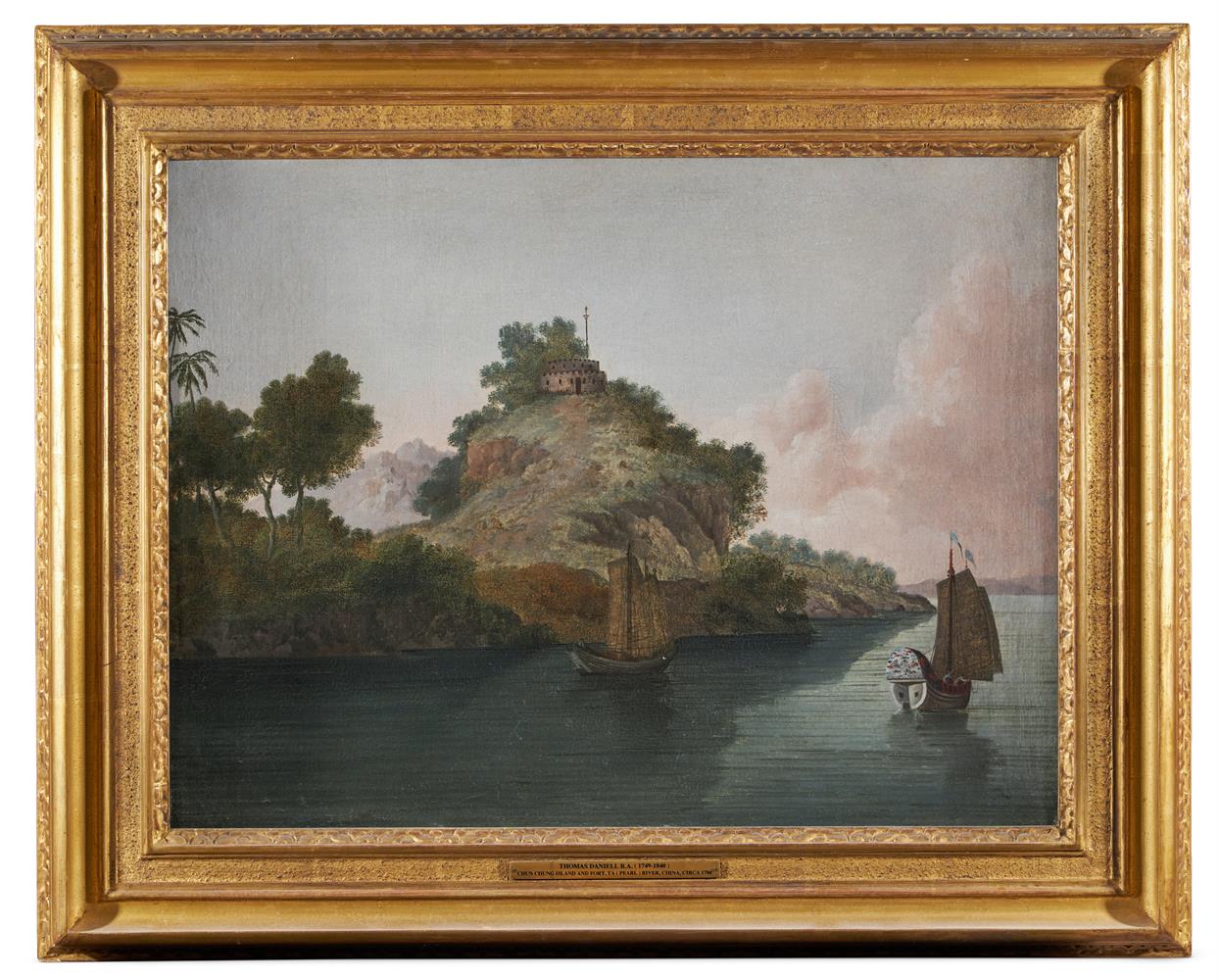THOMAS DANIELL (BRITISH 1749-1840) AND WILLIAM DANIELL (BRITISH 1769-1837) DUSASUMADE GAUT, BERNARES, UTTAR PRADESH Watercolour and pencil, with watermark 'J WHITMAN' Inscribed with title (to the mount); further inscribed and numbered '52' (verso) 37 x 54cm (14½ x 21¼ in.)Provenance: The collection of the artist The Bromley-Davenport family, Capesthorne Hall, Cheshire Thence by descent until 1951 The Peninsular and Oriental Steam Navigation Company (P&O) 1952 - 1996 Sale, Christie's, London, India Observed, 24 September 1996, lot 22 Spink, London, No. K3 11110 A Private CollectionExhibited: London, Commonwealth Institute, 1960, No. 21 Washington D.C, Smithsonian Institute, 1962, No. 9 London, Spink and Son, 1974, No. 41Literature: Archer, M, Early Views of India: The Picturesque Journeys of Thomas and William Daniell 1786 - 1794, Thames and Hudson, 1980, p. 123, ill. No. 71 (aquatint engraving for Part I, Oriental Scenery, No.16) Engraved: T. Daniell, aquatint engraving, May 1796, for Oriental Scenery, vol.I, No. 16The Dasasamadhi Ghat is one of the five most celebrated places of pilgrimage in Bernares, and is where Brahma was said to have sacrificed ten horses. On 22 August 1812, Lady Nugent said of Bernares: 'The city is situated on a high semicircular bank and reaches down to the water's edge. Mosques, pagodas, temples, houses of different sorts - long flights of steps, leading to places of worship - the river, magnificently extended...nothing can be more striking and imposing than the first view of Bernares'. (Archer, p. 123)The series of aquatints of India were published by Thomas and William Daniell between 1795 and 1810. At the time, the aquatint technique was very new in Britain, being introduced by Paul Sandy in 1775. These prints were engraved by the Daniells themselves from their own drawings and watercolours. The present lot is one of the watercolour sketches for number sixteen in Part I of the Oriental Scenery series. In her book, Mildred Archer arranges the illustrations produced by the Daniells in order of their journey, rather than the order in which the aquatints were eventually published, often accompanied by unpublished quotes taken from the small octavo booklets of comments which Thomas Daniell issued with each part of Oriental Scenery. This places the creation of Dusasumade Gaut at circa 17-25 November 1789. Thomas Daniell (1749-1840) was William's (1769 - 1837) uncle. After his father's death Wiliam's mother was left with five children and the burden of running the family pub, which had previously belonged to Thomas's father before passing to his brother. It is thought that Thomas took over responsibility for his nephew to help ease the pressures placed on his sister-in-law.In 1784, when the pair left for India, they were relatively unknown. William was barely fifteen when the pair set sail, and despite having some success in London, in 1773 Thomas had entered the Royal Academy schools, exhibiting thirty pictures over the next decade or so, William had yet to decide what type of painter he should be. When in 1781 he secured a commission for six paintings of West Wycombe Park, and went on to paint the landscapes of Somerset, Yorkshire, and Oxfordshire over the course of the following three years, he seems to have settled on landscapes. However, opportunities for landscape painters were few. As a result, most British artists focused on portraiture with Reynolds and Gainsborough as the leading names. Fueled by the voyages of Captain Cook, it was also around this time that a general interest in the 'exotic', ''picturesque' and the 'sublime' was starting to creep in to British culture. A perfect backdrop then, for the Daniells to explore the opportunities on offer in this exciting new area of the world.During this time, the East India Company had grown substantially and held increasing power in large areas of the British controlled subcontinent. As such, it was possible for English artists to travel freely, an
THOMAS DANIELL (BRITISH 1749-1840) AND WILLIAM DANIELL (BRITISH 1769-1837) DUSASUMADE GAUT, BERNARES, UTTAR PRADESH Watercolour and pencil, with watermark 'J WHITMAN' Inscribed with title (to the mount); further inscribed and numbered '52' (verso) 37 x 54cm (14½ x 21¼ in.)Provenance: The collection of the artist The Bromley-Davenport family, Capesthorne Hall, Cheshire Thence by descent until 1951 The Peninsular and Oriental Steam Navigation Company (P&O) 1952 - 1996 Sale, Christie's, London, India Observed, 24 September 1996, lot 22 Spink, London, No. K3 11110 A Private CollectionExhibited: London, Commonwealth Institute, 1960, No. 21 Washington D.C, Smithsonian Institute, 1962, No. 9 London, Spink and Son, 1974, No. 41Literature: Archer, M, Early Views of India: The Picturesque Journeys of Thomas and William Daniell 1786 - 1794, Thames and Hudson, 1980, p. 123, ill. No. 71 (aquatint engraving for Part I, Oriental Scenery, No.16) Engraved: T. Daniell, aquatint engraving, May 1796, for Oriental Scenery, vol.I, No. 16The Dasasamadhi Ghat is one of the five most celebrated places of pilgrimage in Bernares, and is where Brahma was said to have sacrificed ten horses. On 22 August 1812, Lady Nugent said of Bernares: 'The city is situated on a high semicircular bank and reaches down to the water's edge. Mosques, pagodas, temples, houses of different sorts - long flights of steps, leading to places of worship - the river, magnificently extended...nothing can be more striking and imposing than the first view of Bernares'. (Archer, p. 123)The series of aquatints of India were published by Thomas and William Daniell between 1795 and 1810. At the time, the aquatint technique was very new in Britain, being introduced by Paul Sandy in 1775. These prints were engraved by the Daniells themselves from their own drawings and watercolours. The present lot is one of the watercolour sketches for number sixteen in Part I of the Oriental Scenery series. In her book, Mildred Archer arranges the illustrations produced by the Daniells in order of their journey, rather than the order in which the aquatints were eventually published, often accompanied by unpublished quotes taken from the small octavo booklets of comments which Thomas Daniell issued with each part of Oriental Scenery. This places the creation of Dusasumade Gaut at circa 17-25 November 1789. Thomas Daniell (1749-1840) was William's (1769 - 1837) uncle. After his father's death Wiliam's mother was left with five children and the burden of running the family pub, which had previously belonged to Thomas's father before passing to his brother. It is thought that Thomas took over responsibility for his nephew to help ease the pressures placed on his sister-in-law.In 1784, when the pair left for India, they were relatively unknown. William was barely fifteen when the pair set sail, and despite having some success in London, in 1773 Thomas had entered the Royal Academy schools, exhibiting thirty pictures over the next decade or so, William had yet to decide what type of painter he should be. When in 1781 he secured a commission for six paintings of West Wycombe Park, and went on to paint the landscapes of Somerset, Yorkshire, and Oxfordshire over the course of the following three years, he seems to have settled on landscapes. However, opportunities for landscape painters were few. As a result, most British artists focused on portraiture with Reynolds and Gainsborough as the leading names. Fueled by the voyages of Captain Cook, it was also around this time that a general interest in the 'exotic', ''picturesque' and the 'sublime' was starting to creep in to British culture. A perfect backdrop then, for the Daniells to explore the opportunities on offer in this exciting new area of the world.During this time, the East India Company had grown substantially and held increasing power in large areas of the British controlled subcontinent. As such, it was possible for English artists to travel freely, an










.jpg)




Testen Sie LotSearch und seine Premium-Features 7 Tage - ohne Kosten!
Lassen Sie sich automatisch über neue Objekte in kommenden Auktionen benachrichtigen.
Suchauftrag anlegen